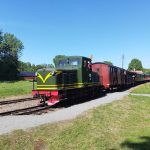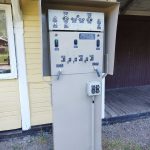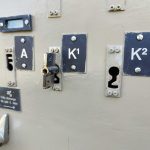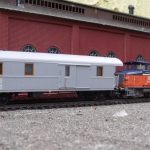Our News
Work continued on our newer replacement model of Åmål station building during July. All window frames were glued into place, and then the glazing material behind them. We then mounted the platform onto the base, and the plinths onto the walls; and put the four sides together, standing on the base, held together with an elastic band! We then decided to add a little detail not included in the kit, and using 0.5mm brass rod, we now have a painted handrail by the steps.


A visit to the ‘LennaKatten’ (Uppsala Lenna Järnväg) seemed a good idea, at least for research purposes; but it was a nice day out in good company, anyway. The research element focussed around Lenna station, where the very traditional signalling (read: locking frame) has been the subject of a short instruction manual; but which left us with more questions than answers. Sadly, the passing loop there is not used in normal service, so observation of the procedures was not possible (it is “switched out” for automatic signal operation). But having a look around the site did help; and this was followed by a lengthy chat with a signalling guy at the railway. Most of our questions are now answered, but a few remain.


We may present an article about this subject at a later date, but for now, a brief overview; and readers who are not interested in railway signalling can skip this paragraph! The locking frame type used at Lenna has keys. These keys are used in the point levers (in pairs) and one or the other can be removed depending on point position. This removed key is inserted into the frame to unlock slide bars, which in turn can unlock the signals. If the Station Master has key type K3 in his possession, he knows that all points are in their normal position. Inserting K3 to a point lever, enables him to change the point, thus releasing a key type K1 or K2. In some instances, this key goes into the locking frame; in other instances the K1 or K2 goes into the lever at a corresponding point to release the other (K2 or K1), which is the one inserted to the locking frame. There are 16 different types of key, but only five are used at Lenna. We would like to recreate this on our eventual new layout, hence the extra interest.




We have acquired another dressin; not another ‘modified Volvo’ but a purpose-built MDR125. It is a static resin model (and cannot be made to work), but it will look good just parked in a siding somewhere! One of the most common service vehicle types of all time is the MDR (MDR = Motordressinen). Many hundreds of dressines were produced from the 1920s until the 1960s. The dressines were used for, among other things, passenger transport and inspections, but also ambulance transport on the Malmbanan. Many have later been scrapped, but some are still used today. However, they have increasingly been replaced by motor trolleys and dual-mode vehicles (cars that can be used on both road and rail) which have more areas of use. (There is no direct English translation for Dressin, so this and the plural Dressines have been spelt accordingly to aid pronunciation, notwithstanding any misinterpretations!) Ours, number 3245 is from the batch MDR 125, nos. 3244-3309, with four doors, built by Bergbolagen Lindesberg in 1956. They ran on petrol, and were also known as ‘meatballs’ or ‘peas’ depending on who you ask!




Other News
We have recently acquired a book from 1979 about service wagons with UIC numbering. From it, we have learned that the UIC letters for service vehicles don’t follow the same rules as most other wagons. For example, an ‘a’ as the second character does not mean that the vehicle is mounted on bogies.
Whilst this explains how our ‘Qab’ can have only two axles (and the ‘Qbd’ is on bogies), it has raised a question about our ‘Qab’, a Heljan model. According to the book, ‘Qab’ applied to a type of plough that was never actually used (an allocated code). Former FV1 vans are shewn as a type ‘Qae’ (Q5) Impregnation works, later Weed control wagon, ‘Qgb’, stores wagon, ‘Qgg’, trailer, ‘Qlh-h’, cleaning wagon (“-h” with drying room), and so it goes on. There is a number list and our wagon 945 4 229 should be a ‘Qgb’ until late 1976, when it was rebuilt to type ‘Hvös’. It was a former FV1, number 25770. Now, curiosity really did get the better of us and we looked in SMJ’s book on 1930s carriages. It was one of the first, built by AB Svenska Järnvägsverkstäderna, Falun in 1937. However, here we learn that after a time as ‘Qgb’, it became ‘Qfa’ (in 1986, after the book was published, so the type isn’t listed). We understand, but this is not confirmed, that the van still exists at Nässjö, where there is a railway museum.

By contrast, our ‘Qbd’ ballast wagons are (Roco) models of a type formerly known (pre-UIC) as ‘Q32b’, and were built by Talbot, 1957-58. Easy!
Behind the Scenes
Mini-Series around the FLMJ; H: The Website
As mentioned earlier in this mini-series, we were not the fastest to go online, and justifiably so. There seemed little need, and everything was ticking over nicely. But, we were often asked if the Railway had a website where people could follow its progress, and ‘put like that’, it seemed a good idea. One of our Friends created both of our websites; the original one using the technology that was available at the time, but was cumbersome to maintain; and the current one, which is closer to basic desktop publication, and can be regularly updated with ease by other members.
The website was naturally intended to bring news about the Railway, and how everything was progressing. It was like a blog, and to some extent remains as such. However, with so much research being necessary, and wanting to share this hobby as much as possible, the website also became a repository of articles relating to the Swedish railways, be they features about locomotives, wagons, signalling systems, or whatever else we have needed to research. And this seems to be the main attraction today (well of course, whilst the FLMJ is closed, there’s not much else to write about)! Much of our research material can be found on the internet, in Swedish; so we present it in English. Only our own updates are available in both languages, and this is something that needs to continue if the Railway is to truly ‘belong’ here.
Nevertheless, there is a genuine fear among railway groups that too much information on the internet is having a backlash, and membership numbers in societies catering for special interests within the hobby are dropping. These specialist Societies have been reporting an average of 20% loss in subscriptions. The British based Scandinavian Railways Society is suffering this effect, and both their former website and our website, may have been contributing to this effect; by giving away so much information online, that there seems little need to join a society, no matter how friendly! They have reigned in their website so that it promotes the Society without giving away too much general knowledge, but will soon have a members’ area where the articles can be placed. We will follow suit, but with edited copies of the articles freely visible, and the more detailed articles available to our Friends. We identify ‘Friend’ (note upper-case ‘F’) as someone who is actively involved with the Railway’s development, maintenance and operation; someone who would be if they weren’t so far away, or have other barriers (but, including regular guests); and someone who has shewn significant interest and with whom we have regular correspondence. So, we feel that this is a suitable way to move forward in this digital age without causing the specialist Societies, the SRS especially, to suffer.
Next month: the Special Reports and Local Promotion